A well-crafted physical therapist resume can be the key to unlocking new career opportunities in the healthcare field. Whether you’re a new graduate entering the workforce or a licensed professional aiming for a leadership role, your resume should reflect your skills, experience, and passion for helping others.
In this guide, we’ll walk you through real-world resume examples, writing tips, must-have sections, and common pitfalls to avoid. By the end, you’ll be equipped with everything you need to create a resume that impresses hiring managers and gets results.

Physical Therapist Resume Examples
Before writing your own, reviewing sample resumes can give you a clearer idea of what works. Below are two examples tailored to different career levels.
Physical Therapist Resume Example 1
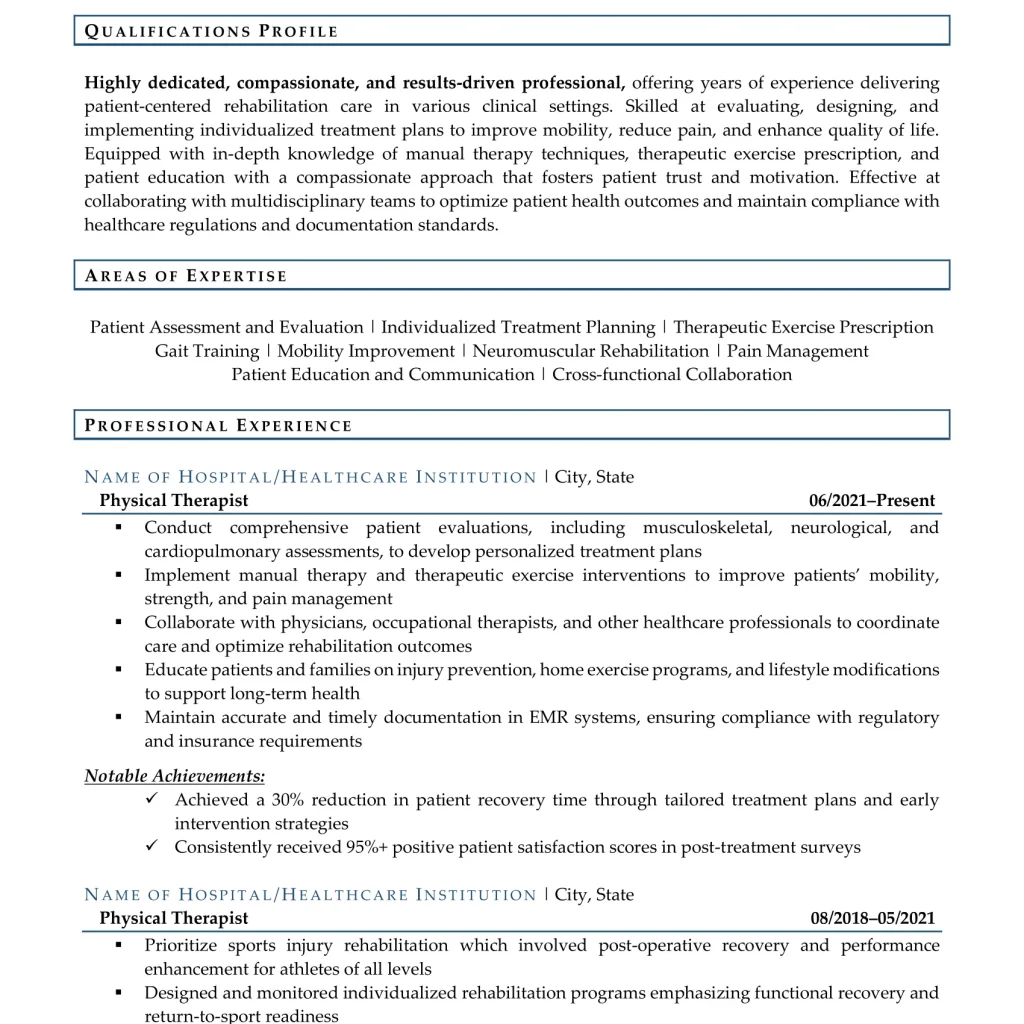
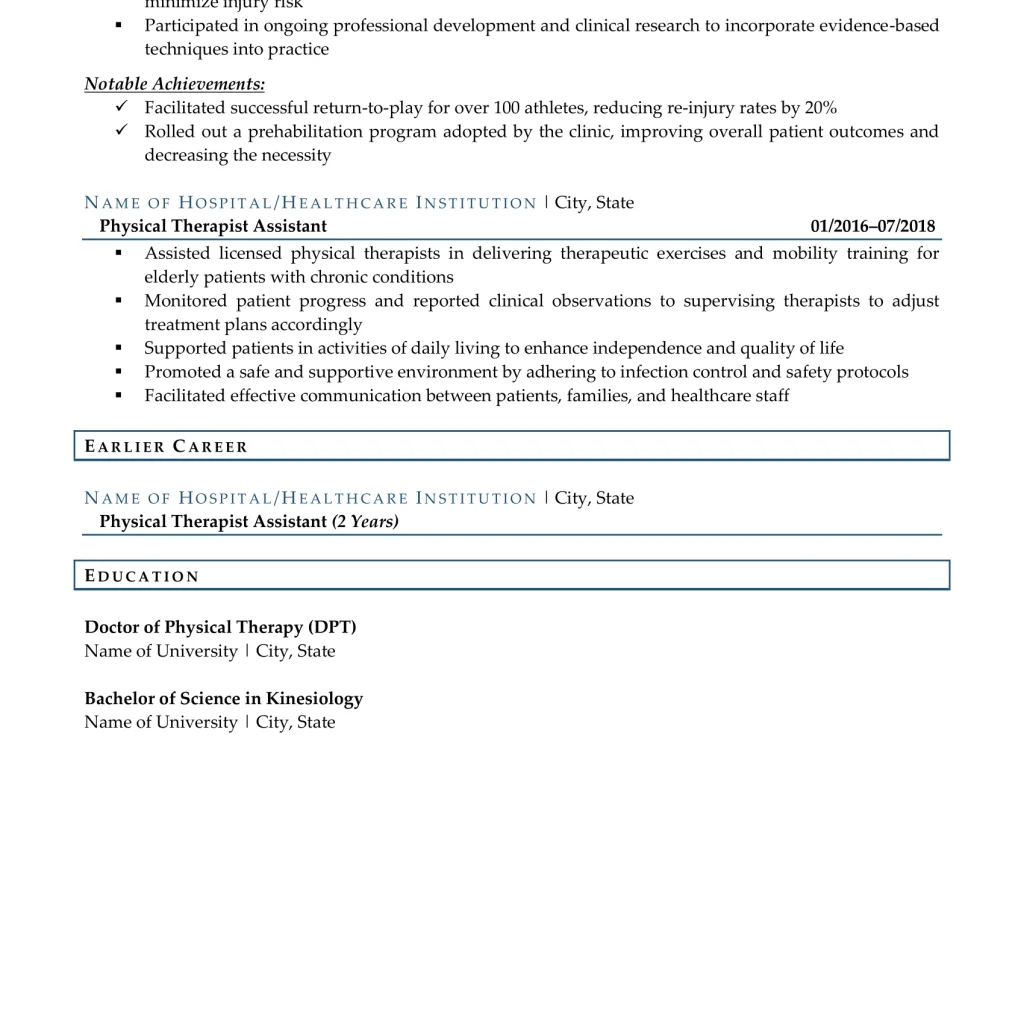
Feel free to download a copy of the Physical Therapist Resume Example 1
Physical Therapist Resume Example 2
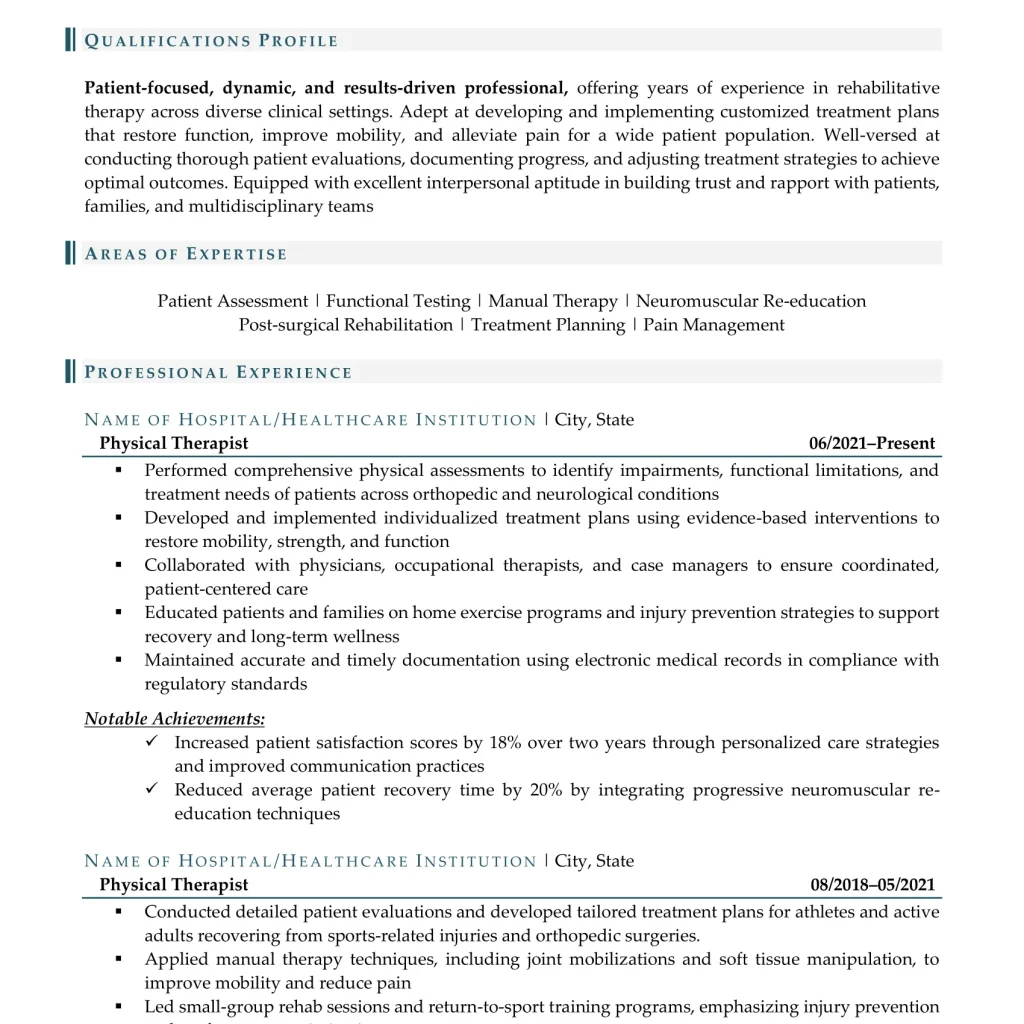
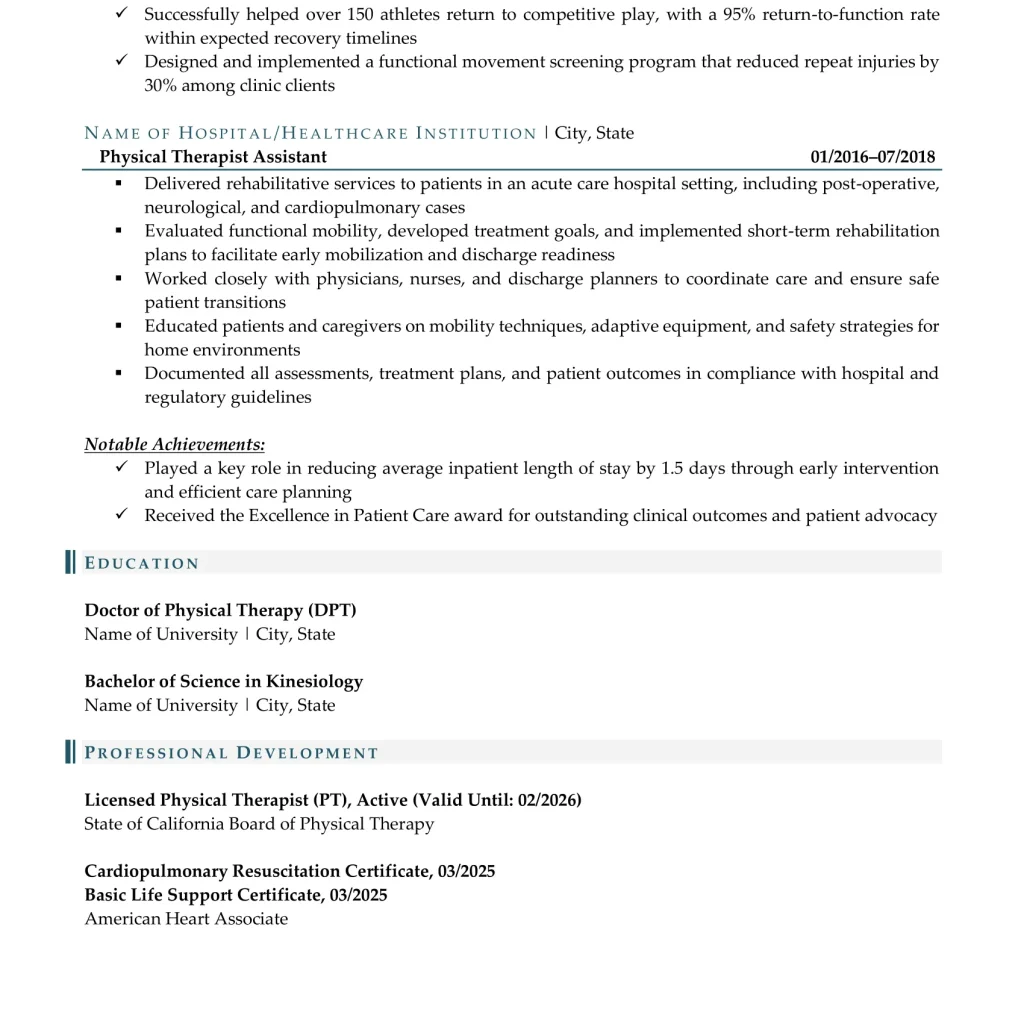
Feel free to download a copy of the Physical Therapist Resume Example 2
Physical Therapist Assistant Resume Example
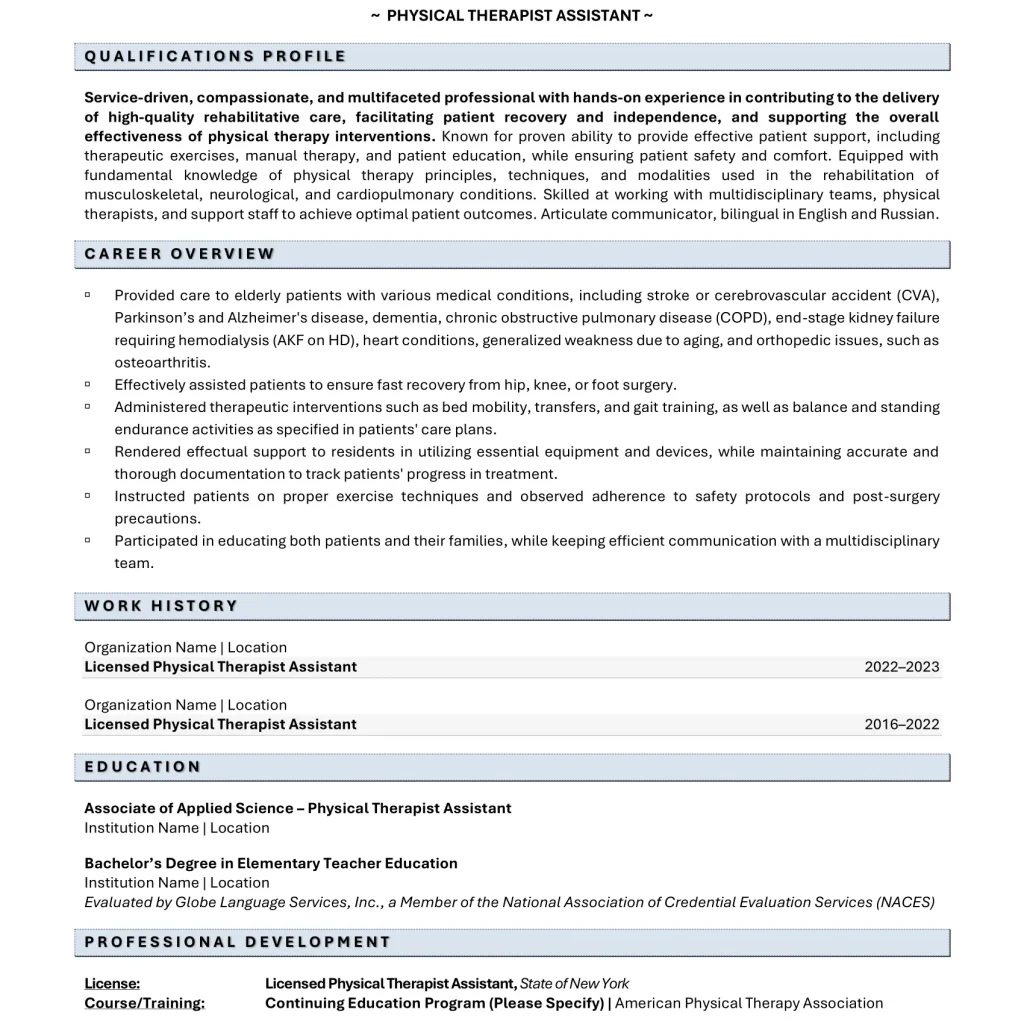
Feel free to download a copy of the Physical Therapist Assistant Resume Example
How To Write a Physical Therapist Resume
Creating a physical therapist resume that stands out takes more than listing job duties. It requires strategic formatting, personalized language, and a clear focus on how your skills meet the employer’s needs.
Here’s a step-by-step guide to help you write it:
1. Choose the Right Format
Stick with a reverse-chronological resume unless you’re making a major career change. This format showcases your most recent and relevant experiences first.
2. Use Action-Oriented Bullet Points
Under each job role or clinical rotation, use bullet points that start with action verbs like “developed,” “treated,” “collaborated,” or “evaluated.”
3. Tailor It to the Job Description
Scan the job posting for relevant keywords (e.g., “manual therapy,” “sports rehab,” “orthopedic conditions”) and incorporate them naturally into your resume.
What to Include in a Physical Therapist Resume
To make your resume competitive and complete, include the following sections:
1. Contact Information
Your contact details should be placed at the very top of your resume so they’re easy to find. Include your full name, phone number, professional email address, and your city and state. Adding a LinkedIn profile is optional but can enhance your credibility if it’s well maintained and up to date.
2. Professional Summary or Objective
This section provides a quick snapshot of your summary of qualifications and what makes you a strong candidate. Use it to summarize your years of experience, area of specialization, and professional strengths. Tailor it to the role you’re applying for so it aligns with the employer’s needs.
3. Education
Start with your Doctor of Physical Therapy (DPT) degree, followed by your undergraduate education. List the degree name, institution, and graduation date for each entry. If you’re a recent graduate, consider adding clinical rotations to this section or listing them separately to highlight hands-on experience.
4. Licensure and Certifications
Listing licenses and certifications is essential to prove your qualifications and readiness to practice. Include your state physical therapy license, NPTE completion, and certifications such as CPR or First Aid. If you have specialty credentials like OCS, NCS, or PCS, be sure to include them as well.
5. Professional Experience
Detail your past roles using clear formatting that includes job title, employer name, location, and dates of employment. Use bullet points to describe your responsibilities, but focus on measurable achievements and patient outcomes. This helps hiring managers see the value you brought to each position.
6. Key Skills
Your skills section should feature both clinical competencies and soft skills relevant to physical therapy. Tailor it to each job application by using keywords from the job description. Examples include therapeutic exercise planning, EMR proficiency, orthopedic rehab, patient education, and time management.
7. Volunteer Work and Affiliations
Include any relevant volunteer experience, especially those related to healthcare or physical therapy. This could involve volunteering at clinics, community wellness events, or rehabilitation centers. Also, mention any memberships in professional organizations like the American Physical Therapy Association (APTA) to show your engagement in the field.
Common Mistakes to Avoid
Even a small mistake on your resume can cost you an interview. Avoid these common pitfalls:
1. Neglecting to Tailor Your Resume
Submitting a generic resume for every job is one of the most common mistakes candidates make. Employers want to see how your skills align with their specific needs and environment. Always tailor your resume to match the job description and highlight relevant experience.
2. Overloading with Medical Jargon
Using complex medical terms can make your resume hard to understand for non-clinical hiring managers or recruiters. While demonstrating expertise is important, clarity is key to ensuring your qualifications are recognized. Aim for language that is both professional and accessible.
3. Omitting Key Metrics
Listing job duties without results can make your resume blend in with others. Employers want to see the impact you made in previous roles. Include measurable achievements—such as improved patient recovery times or satisfaction ratings—to strengthen your credibility.
4. Using an Unprofessional Format
Your resume’s format plays a big role in first impressions. Overly creative or cluttered layouts can distract from your qualifications and confuse ATS software. Stick with clean, organized templates that are easy to read and professionally styled.
5. Ignoring Soft Skills
Soft skills are essential in physical therapy, where patient interaction is constant. Traits like empathy, teamwork, and communication can significantly enhance patient outcomes. Be sure to include examples of how these skills have shaped your professional success.
Cover Letter Tips for Physical Therapists
Your resume gets you noticed—your cover letter makes the connection. A well-written cover letter can convince hiring managers that you’re the right fit for their team.
1. Address the Hiring Manager
Whenever possible, personalize your greeting to show effort and attention to detail. Using a specific name or department (e.g., “Dear Hiring Manager at Harmony Rehab”) creates a stronger connection. It also signals that you’ve taken the time to research the organization.
2. Open with a Strong Introduction
Begin by stating the position you’re applying for and why it interests you. Briefly highlight what makes you a strong candidate based on your background or clinical experience. This sets the tone for the rest of the letter and grabs the reader’s attention.
Example:
I am writing to express my interest in the Physical Therapist position at Harmony Rehab. As a licensed PT with five years of experience and a background in orthopedic and sports injury rehabilitation, I’m confident in my ability to support your team and improve patient outcomes. My dedication to personalized care and measurable results aligns with your clinic’s mission.
3. Highlight Specific Accomplishments
Select 1–2 key achievements that demonstrate your effectiveness as a physical therapist. This could include improved patient outcomes, innovative treatment plans, or reduced recovery times. Sharing these results helps the employer envision your impact on their team.
4. Show Your Passion
Your enthusiasm for helping others should be clear and sincere. Mention why you chose physical therapy and how it fulfills your professional goals. Employers want to hire therapists who genuinely care about patient well-being and long-term recovery.
5. End With a Call to Action
Close your letter by thanking the hiring manager for their time and consideration. Express your interest in discussing the position further during an interview. A confident yet courteous closing encourages a response and reinforces your professionalism.
Move Your PT Career Forward with a Resume That Works
Crafting a compelling physical therapist resume is essential to standing out in today’s competitive healthcare job market. From showcasing your clinical experience and certifications to tailoring each application with relevant keywords and measurable achievements, your resume serves as a powerful tool to communicate your qualifications and passion for patient care. Whether you’re a new graduate or an experienced PT professional, a well-structured resume can highlight your value, make a strong first impression, and increase your chances of landing interviews at top facilities.
If you’re unsure where to begin or want to ensure your resume meets the highest professional standards, Resumeds is here to help. Our expert resume writers specialize in healthcare and allied health careers, delivering personalized, ATS-optimized resumes that position you for success. We understand what hiring managers look for—and we’ll help you present your strengths with clarity and confidence.
Contact Resumeds today and let us help you take the next step in your physical therapy career with a resume that truly stands out.
